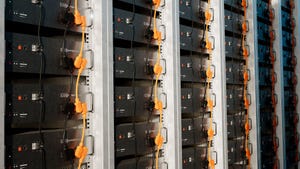Signs of Progress on Government 2.0Signs of Progress on Government 2.0
Federal CTO Aneesh Chopra and his deputy, Chris Vein, were on stage with Tim O'Reilly at the Strata Summit, and came bearing hopeful news. Chopra said the U.S. is "on the cusp of a data revolution in government."
September 21, 2011

Panel-Chris-Vein-Aneesh-Cho
Chris Vein, Deputy United States Chief Technology Officer for Government, Aneesh Chopra is the US Chief Technology Officer and an Assistant to President Obama for Technology within the Office of Science & Technology Policy speak on a panel on Government's Big Data Opportunity with event host Tim O'Reilly of O'Reilly Media.
Tim O'Reilly framed the discussion with a question: "What if government regulation wasn’t all 19th century stacks of paper, but operated with the efficiency of Google search?" The question is at the heart of Government 2.0, the effort to use data and technology to transform government into a platform for innovation.
Fortunately, U.S. Chief Technology Officer Aneesh Chopra and his deputy, Chris Vein, were on stage with O'Reilly at the Strata Summit held Tuesday in New York, and they came bearing hopeful news.
"I would argue that we’re on the cusp of a data revolution in government," said Chopra, citing the release unprecedented amount of federal spending data on Data.gov, which now houses 389,919 datasets and 1,073 government apps. The web site (hosted on the Verizon/Terremark cloud computing service) also offers 236 applications developed by citizens.
Obama Hails Open Government
Across town at the United Nations Chopra's boss, President Barack Obama, hailed the progress made by the eight founding nations in the Open Government Partnership, and said 40 more nations had committed to join the movement in the coming year.
There are plenty of area where federal, state and local governments continue to be weighed down by bureaucracy and inefficiency. But the Strata Summit - part of a week-long schedule of O'Reilly events examining "big data" - focused on opportunity for data and technology to transform both business and government.
Chopra highlighted a success story: the “Blue Button” - a web-based feature which allows veterans and Medicare beneficiaries to easily download their health information and share it with health care providers and caregivers. In the last year more than 400,000 Americans have downloaded their medical data, said Chopra.
"It’s been an amazing year," said Vein. "Our federal agencies all have active plans for open government."
The progress on open government comes as the Obama administration pursues a data center consolidation to eliminate waste. The U.S. government has shut down 39 data centers so far this year, and expects to close 98 more by the end of 2011. The plan calls for 800 of the government’s 2,094 data centers to be closed by 2015, with their workloads shifted to more efficient data centers or cloud computing platforms.
The consolidation, like the open government effort, highlights both the opportunities and challenges in reforming government - a hot topic in Washington these days.
New York City and its BigApps
Another open government success story is found in the host city for the Strata events. New York City CIO Carole Post noted that Mayor Michael Bloomberg knows a few things about finding value in data, and has applied that experience as mayor.
New York publishes more than 400 datasets on a section of its public web site, the NYC Data Mine. The city is developing a next-generation portal, the NYC Platform, to make it even easier for the public to find and use city data. The city has sponsored several BigApps competitions for developers, and is gathering suggestions for new apps from NYC residents for future editions.
To support its data transformation, New York City has opened a new data center in Brooklyn where the city will centralize the IT infrastructure for more than 40 city agencies over the next five years. The city invested $11.7 million in equipment to outfit the 18,000 square-foot facility, and will pay $2.7 million annually to lease the space at the MetroTech Center, but stands to save it more than $100 million over five years.
About the Author
You May Also Like







